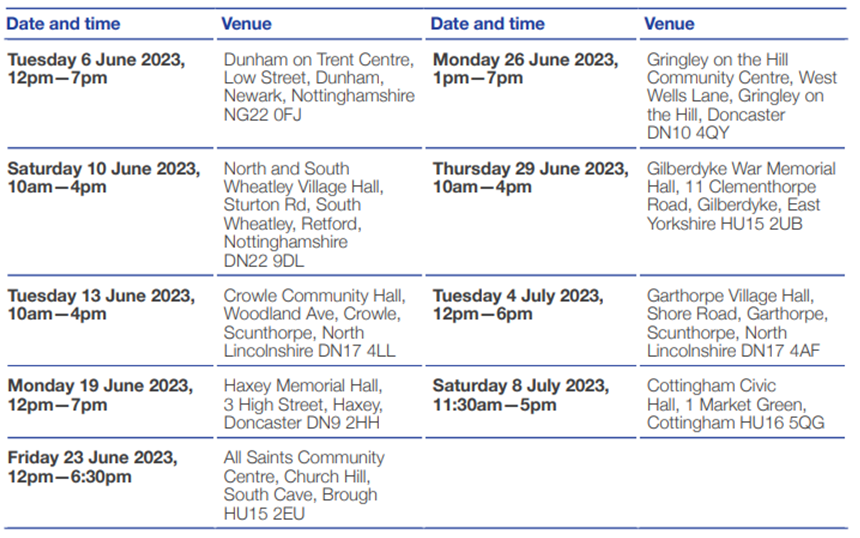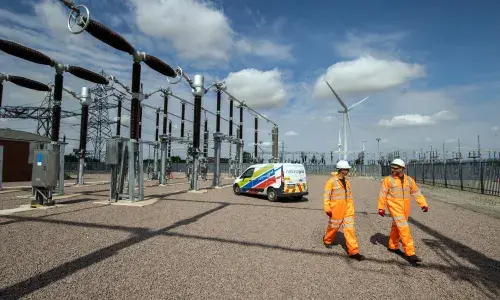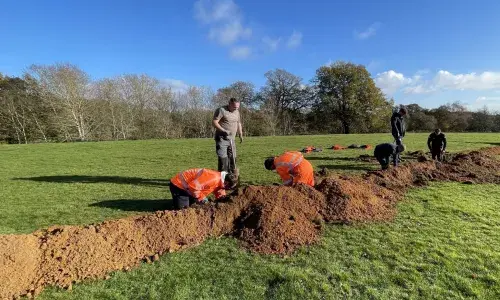
National Grid invites local community to share views on proposals for electricity upgrade project in Yorkshire, North Lincolnshire and Nottinghamshire
-
Proposals for North Humber to High Marnham include 90km of new power line between a new substation near Creyke Beck, North of Hull and a new substation at High Marnham in Nottinghamshire, much of which runs parallel to an existing overhead power line.
-
The upgraded infrastructure will be able to transport 6 gigawatts of power – enough to power 6 million homes.
-
National Grid will consult communities for eight weeks to introduce the project and ask for local peoples’ opinions.
-
The project forms part of The Great Grid Upgrade, the largest overhaul of the grid in generations, with new infrastructure across England and Wales helping the UK meet its net zero ambitions, reduce its reliance on fossil fuels also contribute to lower energy bills over the long-term.
National Grid is inviting communities in the East Riding of Yorkshire, North Lincolnshire and Bassetlaw in Nottinghamshire to comment on proposals for a new electricity power line project that will help deliver the UK’s energy security strategy and net zero targets.
The eight-week public consultation, which starts on 1 June and runs until 27 July, will share proposals for North Humber to High Marnham, a new high-voltage electricity power line.
The way electricity is generated in the UK is changing rapidly, transitioning to cheaper, cleaner and more secure forms of energy like new offshore windfarms. National Grid is making changes to the network of overhead lines, pylons, cables and other infrastructure that transports electricity around the country, so that everyone has access to the clean electricity from these new renewable sources.
Our existing power lines between the North and the Midlands do not have sufficient capacity to accommodate the increased power flows from these new sources of renewable electricity, so we are proposing to build approximately 90 kilometres of new 400,000 volt (400kV) overhead power line, between new substations at Creyke Beck and High Marnham, to increase the capacity of the network. The proposed corridor for the new line runs close to an existing overhead power line for much of the route.
The proposals are based on cost, engineering and environmental assessments as well as impacts on biodiversity, ecology, the historic environment and visual landscape. The cost of all National Grid projects are ultimately paid for by consumer energy bills, and although new onshore power lines are significantly cheaper than an equivalent offshore solution, we develop proposals that take cost, engineering and environmental assessments and other impacts into consideration.
The proposals follow the publication last year of National Grid Electricity System Operator’s ‘Pathway to 2030 Holistic Network Design’ which established the onshore and offshore electricity transmission network reinforcements required to meet government net zero targets, including the North Humber to High Marnham project.
The project also forms part of National Grid’s Great Grid Upgrade, which will see significant new infrastructure built across England and Wales to move more clean energy from where it’s generated to where it’s needed, helping the UK meet its net zero ambitions and reduce its reliance on fossil fuels. By connecting more clean, renewable energy from where it’s generated out at sea to where it’s needed by communities across the UK.
The Great Grid Upgrade will also contribute to lower energy bills over the long-term, provide a catalyst for a green jobs boom and make the UK’s energy more self-sufficient. The UK government suggests that investment in onshore network infrastructure could support up to 130,000 jobs and contribute an estimated £4-11bn of GVA (gross value added) to Great Britain’s economy in 2050*.
We’re proposing new infrastructure that will connect this green energy from areas around the Humber and in the North Sea to the grid and allow clean electricity to power homes and businesses across the Midlands and to the whole country, boosting our home-grown energy security and progress towards net zero.
Rachel Tullis, Project Director for National Grid said: “The government’s net zero target means an increase in new renewable electricity generation such as wind and solar power.
“We’re proposing new infrastructure that will connect this green energy from areas around the Humber and in the North Sea to the grid and allow clean electricity to power homes and businesses across the Midlands and to the whole country, boosting our home-grown energy security and progress towards net zero.
“As we continue to develop our plans, we want to work with local communities and organisations to ensure local employment, skills and opportunities for local businesses are delivered in the East Riding of Yorkshire, North Lincolnshire, and Nottinghamshire.
“This consultation launch is the beginning of our engagement with communities and stakeholders along the proposed route corridor and we encourage people to share their views.”
The project is still at an early stage of development and this public consultation will give local communities the first opportunity to see the plans and to provide feedback. National Grid will listen carefully to the views of the local community and will take their comments into consideration as they develop the proposals in more detail.
Members of the public can take part in the consultations and speak with National Grid’s team by attending consultation events and online webinars, or by visiting nationalgrid.com/nh-hm
Paper copies of consultation materials will also be available to view at several locations in the local area.

The project is classified as Nationally Significant Infrastructure Project under the Planning Act 2008 and requires a special type of planning application; a Development Consent Order (DCO). An independent panel of inspectors is appointed to review the plans of any DCO application. The inspectors issue a recommendation to the Secretary of State for Energy Security & Net Zero who makes the final decision whether to grant planning permission.
Contact for media information only:
Helen Blake +44 7790 824788
Notes to Editors:
National Grid has recently launched the largest overhaul of the grid in generations. The Great Grid Upgrade is part of National Grid’s continued programme of investment into the UK energy transition, which will see £16bn invested from 2021-2026 to support the UK’s net zero goals. National Grid is one of the largest green investors in the FTSE.
*The Department for Energy Security and Net Zero is consulting on a recommended approach to community benefits for electricity transmission network infrastructure.


